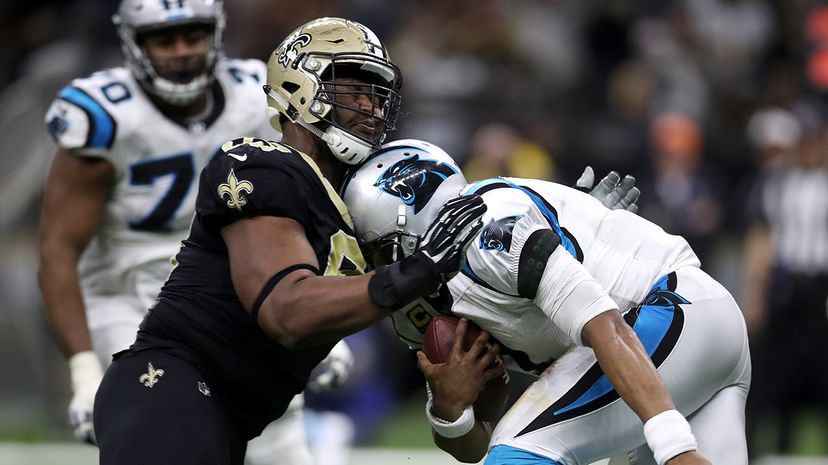 “Carolina Panthers’ QB Cam Newton was hit so hard by New Orleans Saints’ defensive tackle David Onyemata during the Jan. 7, 2018 NFL Wildcard game that he sat dazed on the field for several minutes, though he was not pulled from the game. Photo by Chris Graythen/Getty Images
“Carolina Panthers’ QB Cam Newton was hit so hard by New Orleans Saints’ defensive tackle David Onyemata during the Jan. 7, 2018 NFL Wildcard game that he sat dazed on the field for several minutes, though he was not pulled from the game. Photo by Chris Graythen/Getty Images
A new study contains more bad news for the once-untouchable game of football.
The study published in the January 2018 issue of the journal Brain found that it may not be only helmet-popping, "ooooooh"-inspiring concussions that can lead to the deadly brain disease known as chronic traumatic encephalopathy (CTE). According to the international study led by scientists at Boston University, something much simpler and more sinister could also be a culprit: constant, repetitive, non-stop (but not necessarily concussive) hits to the head, the kind that begin when kids first strap on helmets in pee-wee football.
For a game that, at least on the NFL level, is slogging through a series of public relations toe-stubs (falling attendance, National Anthem protests, bad-boy players, owner infighting), this is about the biggest hit it could get. And it’s one that could — some say absolutely should — reverberate through all levels of the sport.
"This is concerning, particularly for kids who are not old enough to make other decisions legally on their own — like to smoke, drink or drive a car," BU’s Lee Goldstein, one of the co-authors of the study, told USA Today. "Just like we don’t allow kids to do those activities, I think we have a moral obligation to protect them from harm."
The study, funded in part by the National Institutes of Health, the U.S. Department of Defense, the U.S. Department of Veterans Affairs and the National Football League, concluded in stark, albeit scientific, terms that the number of hits, not necessarily the size of them, can cause CTE:
"Collectively, these results raise concern that repetitive neurotrauma, independent of concussion, may induce early CTE brain pathologies, even in teenagers and young adults."
Many veterans, especially those who have seen battle, are believed to also suffer from CTE, which is why the DoD and Veterans Affairs helped fund the study. And sports other than football have athletes who get concussions and repeated blows to the head, too. Ann McKee, the director of BU’s CTE Center and a co-author of the study, points out a simple answer to the problem:
"In order to reduce CTE risk … there must be a reduction in the number of head impacts. The continued focus on concussion and symptomatic recovery does not address the fundamental danger these activities pose to human health."
Bennet Omalu, a forensic pathologist who is credited with discovering CTE, has long warned against the risks of concussions and repeated head trauma. He’s apparently been heard. Participation in high school football dropped slightly in the 2015-16 season, according to the National Federation of State High School Associations, even as participation in other sports spiked.
In late 2017, a study of the brains of 111 deceased NFL players showed that all but one — 110 men — had CTE. Omalu told the New York Press Club shortly afterward that parents should not let any child under the age of 18 play football. "It is the definition of child abuse," he said.
"We wouldn’t let children smoke a stick of cigarette, but then send them to a football field to sustain concussions? So I think it’s time for society to tell the truth."
This latest study, published in Brain less than three weeks before Super Bowl LII, may help a few more parents see the light … before it’s too late.
Now That’s Interesting
The scientists in the study looked at the brains of four deceased high school athletes who had been diagnosed with head injuries. The researchers speculated that the teenagers’ injured brains — one was in the early stages of CTE — could have resulted from damaged vessels that leaked a blood protein into the brain that caused inflammation. The researchers tested their hypothesis on mice. The scientists found the protein and inflammation — CTE-like symptoms — in the mice, even those without concussions.



























